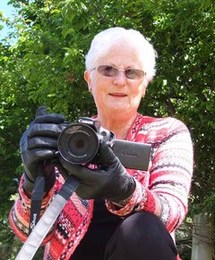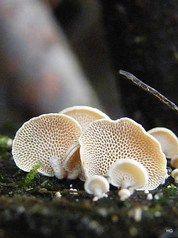
As illness slowed her down, Heather Gardner gradually saw more.
 Dictyopanus pusillus (ping-pong bat), Wonthaggi wetlands. Photo: Heather Gardner
Dictyopanus pusillus (ping-pong bat), Wonthaggi wetlands. Photo: Heather Gardner By Catherine Watson
SHE had always been a walker and an observer but it was illness that made all the difference. Forced to slow down, Heather Gardner gradually saw more. As the expanse of her wanderings shrank, the intensity of her gaze deepened.
“I’d stop to look at one lot of fungi and see another. If I look up at a bird I’m just as likely to fall over. Fungi has become my thing because it doesn’t get up and run away.”
Her great achievement has been to capture the majesty and grandness of these tiny organisms in her photographs. Whole worlds in something not much bigger than a thimble.
Which brings her to another thought. “I’m sorry if you’re an evolutionist,” she says when I visit her, “but I’m a creationist. The more I learn, the more I realise there has to be an intelligent God out there who made all this. It’s just so beautiful.”
******
Heather Gardner was born in Wonthaggi in 1947, the second of six children. Her father was an electrical engineer for the State Coal Mines and the family lived in an old house behind the mine office, near the hospital. It was a happy childhood. The mine area was surrounded by bush and she loved exploring.
She’s astonished now when she remembers some of the things they got up to. “We’d go into the miners’ changing rooms and swap their tokens around. There was a turntable to turn the steam engine around. We’d turn it half way. And we’d climb the steam train water towers and go for a swim. I would have died if my children had done anything like that!”
When she left school, she crossed the hills to go nursing at Warragul Hospital. Then she nursed at Prince Henry’s Hospital in the city and the Western General Hospital, married and had a son and daughter. The family settled at Mooroolbark and she moved into community nursing.
In the late 1980s, they shifted to Wonthaggi and Heather started work as a community nurse at the San Remo Community Health Centre, where she was to work for 22 years. She rediscovered her love of the bush and sea. She became a shell collector, scouring the beaches, building her collection and her knowledge.
So life might have gone on but in 2009, after a peculiar episode of which she had no recollection, she was diagnosed with transient epileptic amnesia. Soon afterwards, she started to lose her balance and was diagnosed with cerebella ataxia, an incurable degenerative condition that affects her balance and makes it difficult for her to travel by car.
Of her condition, or conditions, she says she has good and bad days. “My life’s no different from anyone else’s. Everyone has ups and downs. It’s how we manage it that’s important. I don’t have to solve the problems of the world. I only have to do things in my little corner.”
Her fear is that one day she won’t be able to go out walking any more. For the moment, for all the difficulties, life is still good, as long as she can put on her rubber boots, grab her camera, call Shae, her Jack Russell, and head off into the bush.
Because she can no longer drive far, her walks are close to home. Her turf is the Wonthaggi wetlands and the Wonthaggi golf course, just over her back fence. They don’t follow the walking paths but their own special tracks through the bush.
She wears rubber boots and takes a walking stick but still there have been many falls. “It doesn’t matter because it’s in the bush. But once I fell into the pond. I was looking at a bird. I managed to hold onto my camera and I got myself out. I hoped I wouldn’t see anyone but there were two women there. I just nodded and kept going. I must have looked like the wild woman from the swamp.”
Today she has tens of thousands of photographs taken within a couple of kilometres of home: fungi, mosses and lichens, of course, but also birds, kangaroos, foxes.
She has so many photos that when she accidentally deleted a folder containing about 9000 fungi photos, she shrugged her shoulders. “I just took more photos.”
That’s the beauty of fungi, although she does notice that some species seem to have disappeared in the past few years.
At first they were just beautiful photos to her, but eventually, as is her way, she wanted to know more. She has several books of fungi and now talks knowledgably about Amanita muscaria and Gymnopilus. One day would like to put her own photographs into a book.
In the meantime, her photos are being used for interpretative boards recently placed throughout the Wonthaggi wetlands. She also prints her photographs with inspirational words and donates them to the local churches.
“They can sell them, or do whatever they want with them. What I really want to say is that we’re surrounded by beauty, if people would only stop and look.”
COMMENTS
October 23, 2014
An exquisite article regarding an amazing lady. Heather, your photographs are absolutely incredible … the fungi, the Wonthaggi lane, and the wildlife, just beautiful. A wonderful talent. Thank you to Heather and Catherine.
Joy Button, Coronet Bay
October 19, 2014
Thank you Heather Gardner for sharing with us your story and exquisite photos. May your powers of observation, your wonder of nature and photographic skills be with you for many more years.
Bob Middleton, Jeetho West
SHE had always been a walker and an observer but it was illness that made all the difference. Forced to slow down, Heather Gardner gradually saw more. As the expanse of her wanderings shrank, the intensity of her gaze deepened.
“I’d stop to look at one lot of fungi and see another. If I look up at a bird I’m just as likely to fall over. Fungi has become my thing because it doesn’t get up and run away.”
Her great achievement has been to capture the majesty and grandness of these tiny organisms in her photographs. Whole worlds in something not much bigger than a thimble.
Which brings her to another thought. “I’m sorry if you’re an evolutionist,” she says when I visit her, “but I’m a creationist. The more I learn, the more I realise there has to be an intelligent God out there who made all this. It’s just so beautiful.”
******
Heather Gardner was born in Wonthaggi in 1947, the second of six children. Her father was an electrical engineer for the State Coal Mines and the family lived in an old house behind the mine office, near the hospital. It was a happy childhood. The mine area was surrounded by bush and she loved exploring.
She’s astonished now when she remembers some of the things they got up to. “We’d go into the miners’ changing rooms and swap their tokens around. There was a turntable to turn the steam engine around. We’d turn it half way. And we’d climb the steam train water towers and go for a swim. I would have died if my children had done anything like that!”
When she left school, she crossed the hills to go nursing at Warragul Hospital. Then she nursed at Prince Henry’s Hospital in the city and the Western General Hospital, married and had a son and daughter. The family settled at Mooroolbark and she moved into community nursing.
In the late 1980s, they shifted to Wonthaggi and Heather started work as a community nurse at the San Remo Community Health Centre, where she was to work for 22 years. She rediscovered her love of the bush and sea. She became a shell collector, scouring the beaches, building her collection and her knowledge.
So life might have gone on but in 2009, after a peculiar episode of which she had no recollection, she was diagnosed with transient epileptic amnesia. Soon afterwards, she started to lose her balance and was diagnosed with cerebella ataxia, an incurable degenerative condition that affects her balance and makes it difficult for her to travel by car.
Of her condition, or conditions, she says she has good and bad days. “My life’s no different from anyone else’s. Everyone has ups and downs. It’s how we manage it that’s important. I don’t have to solve the problems of the world. I only have to do things in my little corner.”
Her fear is that one day she won’t be able to go out walking any more. For the moment, for all the difficulties, life is still good, as long as she can put on her rubber boots, grab her camera, call Shae, her Jack Russell, and head off into the bush.
Because she can no longer drive far, her walks are close to home. Her turf is the Wonthaggi wetlands and the Wonthaggi golf course, just over her back fence. They don’t follow the walking paths but their own special tracks through the bush.
She wears rubber boots and takes a walking stick but still there have been many falls. “It doesn’t matter because it’s in the bush. But once I fell into the pond. I was looking at a bird. I managed to hold onto my camera and I got myself out. I hoped I wouldn’t see anyone but there were two women there. I just nodded and kept going. I must have looked like the wild woman from the swamp.”
Today she has tens of thousands of photographs taken within a couple of kilometres of home: fungi, mosses and lichens, of course, but also birds, kangaroos, foxes.
She has so many photos that when she accidentally deleted a folder containing about 9000 fungi photos, she shrugged her shoulders. “I just took more photos.”
That’s the beauty of fungi, although she does notice that some species seem to have disappeared in the past few years.
At first they were just beautiful photos to her, but eventually, as is her way, she wanted to know more. She has several books of fungi and now talks knowledgably about Amanita muscaria and Gymnopilus. One day would like to put her own photographs into a book.
In the meantime, her photos are being used for interpretative boards recently placed throughout the Wonthaggi wetlands. She also prints her photographs with inspirational words and donates them to the local churches.
“They can sell them, or do whatever they want with them. What I really want to say is that we’re surrounded by beauty, if people would only stop and look.”
COMMENTS
October 23, 2014
An exquisite article regarding an amazing lady. Heather, your photographs are absolutely incredible … the fungi, the Wonthaggi lane, and the wildlife, just beautiful. A wonderful talent. Thank you to Heather and Catherine.
Joy Button, Coronet Bay
October 19, 2014
Thank you Heather Gardner for sharing with us your story and exquisite photos. May your powers of observation, your wonder of nature and photographic skills be with you for many more years.
Bob Middleton, Jeetho West